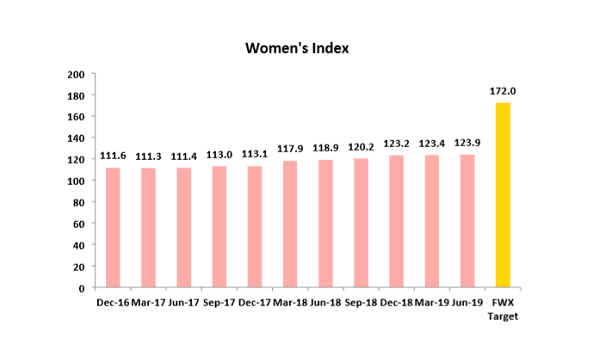The latest Financy Women’s Index shows that progress on economic equality for women has slowed over the past financial year. Based on current trends, Australian women are 45 years away from the same financial experiences as men.
The Women’s Index rose just 0.5 points to 123.9 points in the June quarter of 2019, from 123.4 points in the March quarter. The Financy Women’s Index has a progress target of 172 points.
While women’s economic progress has improved 5 points over the 2018-19 financial year, it’s less than the 7.5 point gain recorded in the 2017-18 financial year when the index score rose to 118.9 points from 111.4 points.
“It’s disappointing to see that despite greater awareness around gender equality, progress slowed over the past financial year, reflecting the weakest start to a calendar year since 2017, when the Index was first launched,” the Financy Women’s Index founder Bianca Hartge-Hazelman says.

The biggest factors that held back women’s economic progress in the June period included a moderation in female full-time employment growth and a lack of action by corporate Australia to improve the representation of women on the boards of the top 200 listed companies.
In June, women occupied 29.7% of ASX 200 board positions, the same as in December 2018. This is particularly disheartening given there was an established target of reaching 30% by the end of 2018.
The factors that supported women’s economic progress, according to the index, include a higher rate of workforce participation, a narrowing of the superannuation gender gap, improved underemployment, higher tertiary enrolments and a lowering gender pay gap.
The latest data on superannuation from the Australian Bureau of Statistics shows that in the 2017-18 financial year, the superannuation gender gap narrowed to 28%, from 34% in the 2015-16 financial year.
“It’s great news that the super gender gap has fallen to its lowest point, but this is being driven largely by women’s increased workforce participation,” AMP Financial Planning adviser Dianne Charman said.
“The super gap widens significantly by 45 years of age because of time spent out of the workforce raising children, so women still need to have a plan for making extra contributions later in their working life.”
AFA Inspire Chair Kate McCallum is delighted that women’s super balances are notching up.
“However I’m also seriously worried that it seems that women’s progress in one area is matched by backward steps in others, like the stalling of full time employment,” she said. “It seems that when some people see improvements in one aspect of women’s equality, they extrapolate this to mean that women have equal opportunities in all areas. And then I’m worried because if they don’t believe that inequality persists, they don’t need to be concerned – or do anything – to bridge the gap.”

